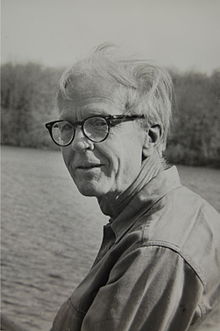Hassler Whitney
Hassler Whitney (born March 23, 1907 in New York City , USA ; † May 10, 1989 in Princeton ) was an American mathematician who mainly dealt with topology and singularity theory, as well as with graph theory at a young age .
life and work
Whitney's father was a judge, one of his grandfathers the astronomer Simon Newcomb , another a famous Sanskrit scholar. Whitney studied at Yale (up to BA 1928) and Harvard, where he received his doctorate in 1932 under Birkhoff with the work The Coloring of Graphs . After a brief stint at the National Research Council, he was first assistant professor in 1935 and finally full professor in 1946 at Harvard. Seven years later he moved to the Institute of Advanced Study at Princeton. He stayed there until his retirement in 1977.
During the Second World War he worked on target devices for air defense and bombs.
In private, Whitney was an avid mountaineer. He was married three times and had a total of five children.
Whitney's most important work was in the field of differential topology , that is, in the then still young theory of manifolds . His best-known result is Whitney's embedding theorem . His work on critical points formed the basis for the catastrophe theory founded by René Thom . In addition, Whitney dealt with vector bundles and made an important contribution to the theory of characteristic classes with his Stiefel-Whitney classes .
In addition to topology, Whitney also dealt with graph theory , combinatorics , where he coined the term matroid , algebraic varieties and integration theory . He also wrote his book Geometric Integration Theory on the latter subject , where, among other things, he provides a theoretical basis for applying Stokes' theorem to manifolds with singularities on their boundary . He also made contributions to the four-color problem (first in his dissertation).
Hassler Whitney has received numerous awards for his work. The most important of these are the National Medal of Science (1976), the Wolf Prize (1983) and the Leroy P. Steele Prize of the American Mathematical Society (1985). In 1950 he gave a plenary lecture at the International Congress of Mathematicians in Cambridge (Massachusetts) (r-dimensional integration in n-space). In 1945 Whitney was elected to the National Academy of Sciences , 1947 to the American Philosophical Society and 1981 to the Académie des Sciences .
literature
- Whitney: Collected papers , 2 vols., Birkhäuser 1992 (Eells, Toledo eds.)
- Kendig: Never a Dull Moment: Hassler Whitney, Mathematics Pioneer , MAA Press 2018, ISBN 978-1-4704-4828-8
- Shields: Differentiable manifolds - Weyl and Whitney , Mathematical Intelligencer 1988, No. 2
Fonts (selection)
- Congruent Graphs and the Connectivity of Graphs. Amer. J. Math. 54 (1932), no. 1, 150-168.
- Analytic extensions of differentiable functions defined in closed sets. Trans. Amer. Math. Soc. 36 (1934), no. 1, 63-89.
- On the Abstract Properties of Linear Dependence. Amer. J. Math. 57 (1935), no. 3, 509-533.
- Differentiable manifolds. Ann. of Math. (2) 37 (1936), no. 3, 645-680.
- The self-intersections of a smooth n-manifold in 2n-space. Ann. of Math. (2) 45, (1944). 220-246.
- The singularities of a smooth n-manifold in (2n − 1) -space. Ann. of Math. (2) 45, (1944). 247-293.
- On singularities of mappings of euclidean spaces. I. Mappings of the plane into the plane. Ann. of Math. (2) 62: 374-410 (1955).
- Elementary structure of real algebraic varieties. Ann. of Math. (2) 66, 1957, 545-556.
- Tangents to an analytic variety. Ann. of Math. (2) 81, 1965, 496-549.
- On the topology of differentiable manifolds , University of Michigan Press 1941
- Geometric integration theory. Princeton University Press, Princeton, NJ, 1957.
- Complex analytic varieties. Addison-Wesley Publishing Co., Reading, Mass.-London-Don Mills, Ont., 1972.
See also
Web links
- Literature by and about Hassler Whitney in the catalog of the German National Library
- John J. O'Connor, Edmund F. Robertson : Hassler Whitney. In: MacTutor History of Mathematics archive .
Individual evidence
- ↑ See New York Times, May 12, 1989 : "Hassler Whitney, a mathematician who made important contributions in geometry and who was deeply involved in improving the teaching of mathematics, died Wednesday at Princeton Medical Center two weeks after suffering a stroke."
| personal data | |
|---|---|
| SURNAME | Whitney, Hassler |
| BRIEF DESCRIPTION | American mathematician |
| DATE OF BIRTH | March 23, 1907 |
| PLACE OF BIRTH | New York City , USA |
| DATE OF DEATH | May 10, 1989 |
| Place of death | Princeton |
